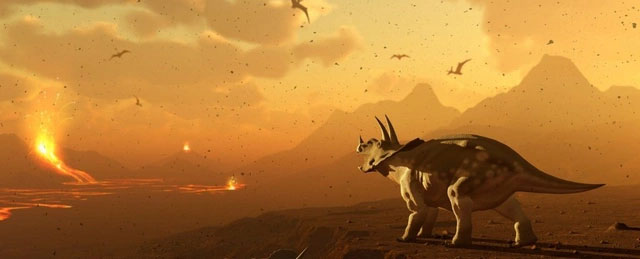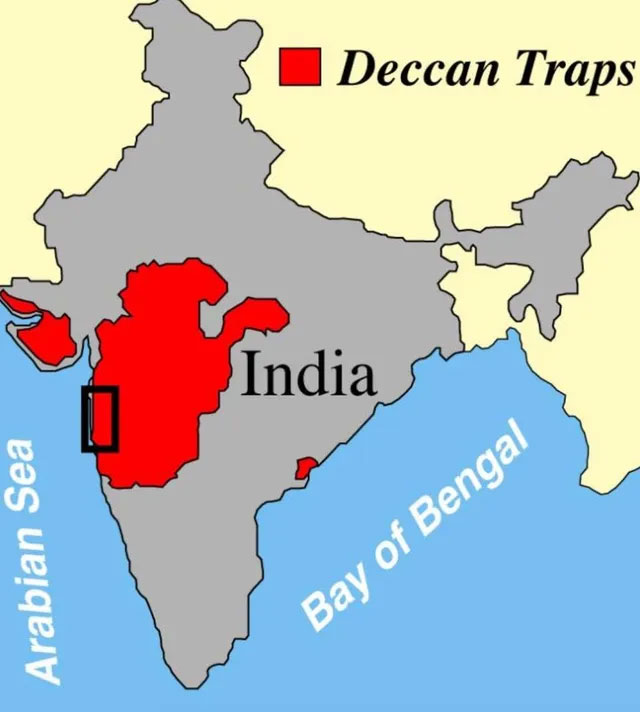The Earth was heavily contaminated with mercury before the collision with the Chicxulub meteorite
A new study has just published that before Chicxulub asteroid hit the Earth 66 million years ago, dinosaurs and other living creatures were faced with toxic levels of mercury.
This new discovery makes the debate 'long-term and fierce' about the cause of extinct dinosaurs even more dramatic. While some scientists claim the dinosaurs disappeared due to a collision between the Earth and Chicxulub asteroid , others persevere believe that there are still many mysteries behind it that need to be discovered.

Did the dinosaurs disappear due to a collision between the Earth and the Chicxulub asteroid?
Intense volcanic eruptions began to appear at least tens of thousands of years before the meteorite and lava collisions were thought to be the factors that exacerbated the effects of the catastrophic event. claimed 3/4 of life on Earth.
Looking at ancient fossil shell samples taken from around the world, scientists have found that global amounts of mercury and carbon dioxide increase after a series of volcanic eruptions. extends the formation of the Deccan Trap . These events lasted nearly a million years and formed much of western India during the Cretaceous-Paleogene mass extinction.
Environmental scientist Kyle Meyer, who conducted the study at the University of Michigan, said, "For the first time, we can gain insight into the different climate and environmental impacts of the Deccan Trap volcano. only by analyzing a single material '.

The amount of CO2 increased after a series of volcanic eruptions that formed the Deccan Trap.
Mercury is a toxic trace chemical and volcanic eruptions are the biggest contributor of mercury to Earth. When this element enters the ocean, it reacts strongly with organic matter and is absorbed by phytoplankton, which later becomes food for mollusks.
Using shell fragments as an indicator of water quality and temperature, scientists now think that volcanic eruptions at the Deccan Trap have a profound, long-term and global impact on climate and livelihood. thai .
Geological researcher Sierra Petersen from the University of Michigan said: "Mercury variations have been reported in sediments but have never been found in seashells."
"The ability to recreate both climate and volcanic indexes on the same material helps us avoid many of the problems associated with relative dating. '
For example, sediment samples are limited because they cannot link mercury emissions with global climate change. But this new research was able to do that.

Model of the volcanic mercury emission cycle.
After collecting fossil shells from Antarctica, Alabama, Alaska, California, Washington State, Argentina, India, Egypt, Libya and Sweden, the authors calculated the amount of CO 2 and mercury in many periods, including the Cretaceous, Pleistocene and modern.
Similar to the previous results, their findings uncovered the secret of a sudden warming event that occurred about 250 thousand years before the mass extinction period. Moreover, this event coincided with an increase in mercury concentrations between 68 and 70 million years ago, when volcanic activity was so intense, creating a 100m thick lava carpet.
The authors claim that this is 'evidence that the high probability of this climate effect is due to volcanic CO 2 emissions ,' and, incidentally, this period coincides with the decline. species abundance and extinction of the species (foraminifera).

An extinct 66 to 72 million year old oyster fossil, Agerostrea ungulata, from the Fezzan region of Libya.
Comparing these ancient data to a site of heavily polluted mercury in the United States, where fish cannot be eaten anymore, the researchers were shocked by the similarities.
Meyer, of Portland State University, said, "It is surprising that the location of the sudden rise in sea temperatures is also the place where the highest concentrations of mercury are found. This mercury has the same amount of mercury as a point of modern industrial mercury pollution '.
It is still too early to say for sure this mercury poisoned the dinosaurs, but as a conceptual proof, this study is very valuable.
Further analysis of marine life is needed to confirm the results, but perhaps fossil marine life will be able to give us deeper insights into mass extinction and past climate change. .
- New discovery of the extinction of dinosaurs
- Quiet assassin from mercury-contaminated fish
- Drilling deep into craters collided by meteors once destroyed dinosaurs
- Discover the largest crater on Earth
- The 50m meteorite may crash into Earth later this year
- 84% of the world fish is contaminated with mercury
- Stone from Mercury has fallen to Earth
- A meteorite grazes the earth
- Overview of Mercury
- The map shows that Earth is continuously attacked by meteors
- Monitor the risk of collisions between giant meteorites and Earth
- NASA admits helplessness against meteors
 'Fine laughs' - Scary and painful torture in ancient times
'Fine laughs' - Scary and painful torture in ancient times The sequence of numbers 142857 of the Egyptian pyramids is known as the strangest number in the world - Why?
The sequence of numbers 142857 of the Egyptian pyramids is known as the strangest number in the world - Why? History of the iron
History of the iron What is alum?
What is alum?